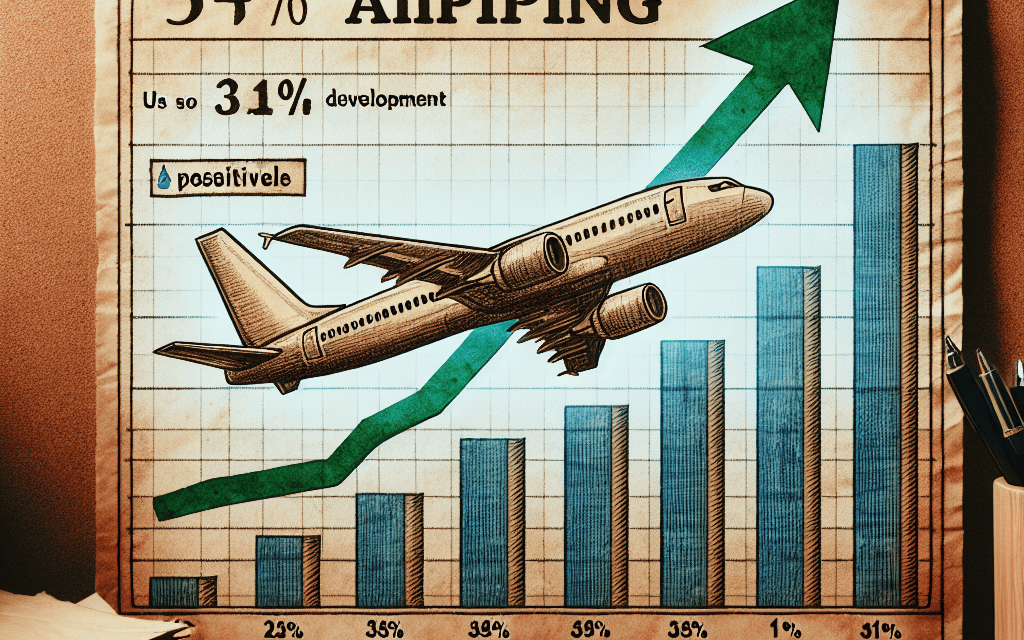“Spirit Airlines Soars: 34% Surge on Promising Horizons!”
Introduction
Spirit Airlines recently experienced a significant surge in its stock value, with shares climbing 34% following a series of positive developments. This remarkable increase reflects investor optimism and confidence in the airline’s strategic initiatives and market position. The surge can be attributed to a combination of factors, including improved financial performance, strategic partnerships, or favorable industry trends, which have collectively bolstered market sentiment. As Spirit Airlines continues to navigate the competitive aviation landscape, these developments signal a promising trajectory for the company, capturing the attention of investors and industry analysts alike.
Impact Of Spirit Airlines’ Stock Surge On The Aviation Industry
The recent surge in Spirit Airlines’ shares, which saw an impressive 34% increase, has sent ripples throughout the aviation industry, prompting analysts and stakeholders to reassess the dynamics within this competitive sector. This remarkable uptick in stock value can be attributed to a series of positive developments that have bolstered investor confidence and positioned Spirit Airlines as a formidable player in the low-cost carrier market. As the industry grapples with fluctuating fuel prices, evolving consumer preferences, and the lingering effects of the global pandemic, Spirit’s resurgence offers valuable insights into the broader implications for the aviation sector.
To begin with, Spirit Airlines’ stock surge is indicative of a renewed optimism in the airline’s strategic direction and operational efficiency. The company has recently implemented a series of cost-cutting measures and operational improvements, which have enhanced its financial stability and competitive edge. These initiatives have not only improved Spirit’s bottom line but have also reassured investors of the airline’s ability to navigate the challenges posed by an ever-changing market landscape. Consequently, this has led to increased investor interest and a subsequent rise in stock prices.
Moreover, the positive developments at Spirit Airlines have underscored the importance of adaptability and innovation in the aviation industry. As airlines worldwide strive to recover from the pandemic-induced downturn, Spirit’s success story serves as a testament to the effectiveness of agile business models and customer-centric strategies. By focusing on enhancing the passenger experience and expanding its route network, Spirit has managed to capture a larger share of the market, thereby setting a benchmark for other carriers to emulate. This shift towards a more customer-focused approach is likely to influence industry trends, encouraging other airlines to prioritize service quality and operational efficiency.
In addition to operational improvements, Spirit Airlines’ stock surge has also been fueled by strategic partnerships and alliances. The airline’s collaboration with other carriers and stakeholders has facilitated access to new markets and resources, further strengthening its competitive position. These partnerships have not only expanded Spirit’s reach but have also contributed to a more interconnected and resilient aviation ecosystem. As a result, the airline’s success has highlighted the significance of strategic alliances in driving growth and innovation within the industry.
Furthermore, the impact of Spirit Airlines’ stock surge extends beyond the company itself, as it has prompted a reevaluation of investment strategies within the aviation sector. Investors are increasingly recognizing the potential of low-cost carriers to deliver substantial returns, particularly in a post-pandemic environment where cost-conscious travelers are seeking affordable travel options. This shift in investor sentiment is likely to influence capital allocation decisions, with more funds being directed towards budget airlines and related ventures. Consequently, this could lead to increased competition and innovation within the low-cost segment, ultimately benefiting consumers through improved services and lower fares.
In conclusion, the 34% surge in Spirit Airlines’ shares has had a profound impact on the aviation industry, highlighting the importance of strategic agility, customer-centricity, and collaborative partnerships. As the sector continues to evolve in response to emerging challenges and opportunities, Spirit’s success story serves as a valuable case study for other airlines seeking to enhance their competitive standing. By embracing innovation and prioritizing operational efficiency, carriers can not only navigate the complexities of the current market but also position themselves for sustained growth and success in the future.
Key Factors Behind Spirit Airlines’ 34% Share Increase
Spirit Airlines has recently experienced a remarkable surge in its share price, climbing by an impressive 34%. This significant increase can be attributed to a confluence of positive developments that have bolstered investor confidence and revitalized the airline’s market position. To understand the factors driving this upward trajectory, it is essential to examine the strategic decisions and external influences that have contributed to this financial upswing.
First and foremost, Spirit Airlines has made substantial strides in enhancing its operational efficiency. By optimizing its flight schedules and streamlining its fleet management, the airline has managed to reduce costs while maintaining a high level of service. This operational overhaul has not only improved profit margins but also positioned Spirit as a more competitive player in the low-cost carrier segment. Consequently, investors have responded favorably to these efforts, viewing them as a sustainable path to long-term growth.
In addition to operational improvements, Spirit Airlines has also benefited from a broader recovery in the travel industry. As global travel restrictions continue to ease and consumer confidence rebounds, there has been a noticeable uptick in passenger demand. Spirit, with its focus on budget-conscious travelers, is well-positioned to capitalize on this resurgence. The airline’s ability to offer affordable fares without compromising on quality has resonated with a growing number of travelers eager to explore new destinations after prolonged periods of confinement.
Moreover, Spirit Airlines has strategically expanded its route network, tapping into underserved markets and increasing its presence in key regions. This expansion has not only diversified its revenue streams but also mitigated risks associated with over-reliance on specific routes. By identifying and seizing opportunities in emerging markets, Spirit has demonstrated its commitment to growth and adaptability in a dynamic industry landscape. Investors have taken note of this proactive approach, further fueling the surge in share prices.
Another pivotal factor contributing to Spirit Airlines’ recent success is its focus on customer experience. Recognizing the importance of customer satisfaction in driving repeat business, the airline has invested in upgrading its in-flight services and enhancing its loyalty programs. These initiatives have not only improved passenger satisfaction but also strengthened brand loyalty, creating a virtuous cycle of positive word-of-mouth and increased bookings. As a result, Spirit has been able to differentiate itself from competitors, attracting a loyal customer base that supports its financial performance.
Furthermore, Spirit Airlines has effectively leveraged technology to streamline its operations and improve customer interactions. By implementing advanced booking systems and utilizing data analytics, the airline has been able to offer personalized services and optimize its pricing strategies. This technological integration has not only enhanced operational efficiency but also provided valuable insights into consumer preferences, enabling Spirit to tailor its offerings to meet evolving demands.
In conclusion, the 34% surge in Spirit Airlines’ share price can be attributed to a combination of strategic initiatives and favorable market conditions. Through operational improvements, strategic expansion, a focus on customer experience, and technological integration, Spirit has positioned itself as a formidable player in the airline industry. As the travel sector continues to recover, Spirit Airlines is well-equipped to sustain its growth trajectory, offering investors a compelling opportunity for future returns. The airline’s ability to adapt and innovate in response to changing market dynamics underscores its potential for continued success in the competitive aviation landscape.
Investor Reactions To Spirit Airlines’ Positive Developments
Spirit Airlines has recently experienced a significant surge in its stock price, with shares climbing 34% following a series of positive developments that have captured the attention of investors. This remarkable increase in share value reflects a renewed confidence in the airline’s strategic direction and operational improvements. As investors digest these developments, it is essential to understand the factors contributing to this upward trajectory and the potential implications for the airline’s future.
One of the primary catalysts for the surge in Spirit Airlines’ stock price is the company’s recent announcement of better-than-expected quarterly earnings. The airline reported a substantial increase in revenue, driven by a combination of higher passenger volumes and improved operational efficiency. This financial performance has exceeded analysts’ expectations, providing a strong signal to investors that Spirit Airlines is on a solid path to recovery and growth. The positive earnings report has not only boosted investor confidence but also underscored the effectiveness of the airline’s cost management strategies and its ability to adapt to changing market conditions.
In addition to the robust financial results, Spirit Airlines has also made significant strides in expanding its route network and enhancing its service offerings. The airline has announced plans to introduce new domestic and international routes, which are expected to attract a broader customer base and increase market share. This strategic expansion is seen as a proactive move to capitalize on the growing demand for air travel, particularly as the industry continues to rebound from the challenges posed by the global pandemic. By diversifying its route portfolio, Spirit Airlines aims to strengthen its competitive position and drive long-term growth.
Moreover, Spirit Airlines has been actively investing in fleet modernization, which has further contributed to the positive sentiment among investors. The airline’s commitment to upgrading its fleet with more fuel-efficient aircraft not only aligns with its sustainability goals but also promises to reduce operational costs in the long run. This investment in modern technology is expected to enhance the overall customer experience, making Spirit Airlines a more attractive option for travelers seeking affordable and reliable air travel. As the airline continues to prioritize sustainability and efficiency, investors are optimistic about its ability to maintain profitability and achieve sustainable growth.
Furthermore, the recent surge in Spirit Airlines’ stock price can also be attributed to broader industry trends that have favored low-cost carriers. As consumers become increasingly price-sensitive, budget airlines like Spirit have gained popularity for offering competitive fares without compromising on essential services. This shift in consumer preferences has provided a tailwind for Spirit Airlines, allowing it to capture a larger share of the market and drive revenue growth. Investors have taken note of this trend, recognizing the potential for continued success in the low-cost segment of the airline industry.
In conclusion, the 34% surge in Spirit Airlines’ shares is a reflection of the positive developments that have unfolded within the company and the broader industry. From strong financial performance and strategic expansion to fleet modernization and favorable market trends, Spirit Airlines has positioned itself as a formidable player in the competitive airline landscape. As investors continue to react to these developments, the airline’s future prospects appear promising, with the potential for sustained growth and profitability. This renewed investor confidence underscores the importance of strategic planning and adaptability in navigating the dynamic aviation industry.
Future Prospects For Spirit Airlines After Stock Surge

Spirit Airlines has recently experienced a remarkable surge in its stock value, with shares climbing 34% following a series of positive developments. This significant increase has captured the attention of investors and industry analysts alike, prompting discussions about the future prospects of the airline. As Spirit Airlines navigates this newfound momentum, several factors contribute to its potential for sustained growth and success in the competitive aviation market.
One of the primary drivers behind the recent surge in Spirit Airlines’ stock is the company’s strategic initiatives aimed at enhancing operational efficiency and customer satisfaction. Over the past few years, Spirit has focused on refining its business model to offer low-cost travel options while maintaining a high standard of service. This approach has resonated well with budget-conscious travelers, allowing the airline to expand its customer base and increase market share. Moreover, Spirit’s commitment to modernizing its fleet with fuel-efficient aircraft has not only reduced operational costs but also aligned with growing environmental concerns, appealing to eco-conscious passengers.
In addition to operational improvements, Spirit Airlines has benefited from favorable market conditions that have bolstered its financial performance. The post-pandemic recovery in air travel demand has been a significant boon for the airline industry, and Spirit has capitalized on this resurgence by strategically increasing its flight capacity and expanding its route network. By tapping into underserved markets and offering competitive fares, Spirit has positioned itself as a formidable player in the domestic and international travel sectors. This expansion strategy has not only driven revenue growth but also enhanced the airline’s brand recognition and customer loyalty.
Furthermore, Spirit Airlines’ recent stock surge can be attributed to its proactive approach to addressing challenges and seizing opportunities in the evolving aviation landscape. The airline has demonstrated resilience in the face of economic uncertainties, such as fluctuating fuel prices and labor shortages, by implementing cost-control measures and optimizing its workforce. Additionally, Spirit’s investment in technology and digital solutions has streamlined operations and improved the overall passenger experience, setting the stage for long-term success.
Looking ahead, Spirit Airlines is well-positioned to capitalize on emerging trends and opportunities in the aviation industry. The growing demand for leisure travel, coupled with the increasing preference for budget-friendly options, presents a favorable environment for Spirit to expand its market presence. Moreover, the airline’s focus on sustainability and innovation aligns with the industry’s shift towards greener practices and digital transformation, further enhancing its competitive edge.
However, it is important to acknowledge the potential challenges that Spirit Airlines may encounter as it charts its future course. The airline industry remains susceptible to external factors such as geopolitical tensions, regulatory changes, and economic fluctuations, which could impact Spirit’s operations and profitability. Additionally, the competitive landscape is constantly evolving, with new entrants and established carriers vying for market share. To maintain its upward trajectory, Spirit must continue to adapt to these dynamics and leverage its strengths to stay ahead of the curve.
In conclusion, the recent surge in Spirit Airlines’ stock value reflects a confluence of positive developments and strategic initiatives that have positioned the airline for future growth. By focusing on operational excellence, market expansion, and innovation, Spirit is poised to navigate the challenges and opportunities that lie ahead. As the airline industry continues to evolve, Spirit Airlines’ ability to adapt and thrive will be crucial in sustaining its momentum and delivering value to shareholders and customers alike.
Analyzing The Market Trends Influencing Spirit Airlines’ Growth
Spirit Airlines has recently experienced a remarkable surge in its stock value, with shares climbing by an impressive 34%. This significant increase can be attributed to a series of positive developments that have captured the attention of investors and market analysts alike. To understand the factors driving this growth, it is essential to examine the broader market trends and specific strategies that have contributed to Spirit Airlines’ recent success.
One of the primary factors influencing Spirit Airlines’ growth is the overall recovery of the airline industry. As the world gradually emerges from the constraints imposed by the COVID-19 pandemic, there has been a notable resurgence in air travel demand. This recovery is fueled by the easing of travel restrictions, the rollout of vaccination programs, and a growing consumer confidence in the safety of air travel. Consequently, airlines, including Spirit, have witnessed a substantial increase in passenger numbers, which has positively impacted their financial performance.
In addition to the general industry recovery, Spirit Airlines has implemented strategic initiatives that have bolstered its market position. The airline has focused on expanding its route network, targeting underserved markets and increasing flight frequencies on popular routes. This expansion strategy not only enhances Spirit’s competitive edge but also attracts a broader customer base, thereby driving revenue growth. Furthermore, Spirit’s commitment to maintaining a low-cost structure has enabled it to offer competitive fares, appealing to budget-conscious travelers and further boosting its market share.
Moreover, Spirit Airlines has embraced technological advancements to enhance operational efficiency and customer experience. The adoption of advanced booking systems, streamlined check-in processes, and improved in-flight services has contributed to a more seamless travel experience for passengers. These technological enhancements not only improve customer satisfaction but also reduce operational costs, thereby positively impacting the airline’s bottom line.
Another critical factor contributing to Spirit Airlines’ recent success is its strategic partnerships and alliances. By collaborating with other airlines and travel companies, Spirit has been able to expand its reach and offer more comprehensive travel solutions to its customers. These partnerships have facilitated code-sharing agreements, joint marketing efforts, and shared loyalty programs, all of which enhance Spirit’s value proposition and attract a wider audience.
Furthermore, Spirit Airlines has demonstrated resilience in navigating the challenges posed by fluctuating fuel prices and economic uncertainties. The airline has implemented effective fuel hedging strategies and cost management practices to mitigate the impact of rising fuel costs. Additionally, Spirit’s agile business model allows it to adapt quickly to changing market conditions, ensuring sustained growth even in the face of economic volatility.
In conclusion, the recent surge in Spirit Airlines’ shares can be attributed to a combination of industry-wide recovery, strategic initiatives, technological advancements, and effective partnerships. As the airline industry continues to rebound, Spirit’s focus on expanding its route network, maintaining a low-cost structure, and enhancing customer experience positions it well for sustained growth. While challenges such as fuel price fluctuations and economic uncertainties remain, Spirit Airlines’ proactive approach and adaptability provide a solid foundation for continued success. Investors and market analysts will undoubtedly keep a close eye on Spirit Airlines as it navigates the evolving landscape of the airline industry, with optimism for further positive developments on the horizon.
Spirit Airlines’ Strategic Moves Leading To Share Price Boost
Spirit Airlines has recently witnessed a remarkable surge in its share price, climbing 34% following a series of strategic developments that have captured the attention of investors and industry analysts alike. This significant increase in share value can be attributed to a combination of factors, including operational improvements, strategic partnerships, and a favorable market environment, all of which have contributed to bolstering investor confidence in the airline’s future prospects.
To begin with, Spirit Airlines has made substantial strides in enhancing its operational efficiency, a move that has not gone unnoticed by market observers. The airline has implemented a series of cost-cutting measures aimed at streamlining its operations and improving its bottom line. By optimizing its flight schedules, reducing turnaround times, and investing in fuel-efficient aircraft, Spirit has managed to lower its operating costs significantly. These efforts have not only improved the airline’s financial performance but have also positioned it as a more competitive player in the low-cost carrier segment.
In addition to operational improvements, Spirit Airlines has also been proactive in forging strategic partnerships that promise to expand its market reach and enhance its service offerings. Recently, the airline announced a codeshare agreement with a major international carrier, allowing it to tap into new markets and offer its customers a wider range of travel options. This partnership is expected to drive additional revenue streams and increase passenger traffic, further solidifying Spirit’s position in the industry.
Moreover, Spirit Airlines has been capitalizing on the current favorable market conditions, which have played a crucial role in the recent surge in its share price. The airline industry, as a whole, has been experiencing a rebound in demand as travel restrictions ease and consumer confidence returns. Spirit, with its focus on leisure travel and budget-conscious consumers, is well-positioned to benefit from this resurgence. The airline’s ability to adapt to changing market dynamics and capture pent-up demand has been a key factor in its recent success.
Furthermore, Spirit Airlines’ commitment to enhancing the customer experience has also contributed to its positive trajectory. The airline has invested in upgrading its in-flight services, improving its loyalty program, and expanding its route network to better serve its passengers. These initiatives have not only helped to attract new customers but have also fostered loyalty among existing ones, thereby driving repeat business and boosting overall revenue.
In light of these developments, it is evident that Spirit Airlines’ strategic moves have played a pivotal role in the recent surge in its share price. The combination of operational improvements, strategic partnerships, favorable market conditions, and a focus on customer experience has created a strong foundation for the airline’s continued growth. As Spirit Airlines continues to execute its strategic vision, it is likely to maintain its upward momentum and further solidify its position as a leading player in the low-cost carrier market.
In conclusion, Spirit Airlines’ recent share price surge is a testament to the effectiveness of its strategic initiatives and its ability to navigate the complexities of the airline industry. By focusing on operational efficiency, strategic partnerships, and customer satisfaction, Spirit has positioned itself for sustained success in the competitive aviation landscape. As the airline continues to build on these positive developments, it is poised to deliver long-term value to its shareholders and stakeholders alike.
Comparing Spirit Airlines’ Performance With Competitors In The Market
Spirit Airlines has recently experienced a remarkable surge in its stock value, with shares climbing 34% following a series of positive developments. This significant increase has drawn attention to the airline’s performance, prompting comparisons with its competitors in the market. To understand the implications of this surge, it is essential to examine the factors contributing to Spirit Airlines’ recent success and how it stands relative to other players in the industry.
One of the primary drivers behind Spirit Airlines’ stock surge is its strategic focus on cost efficiency and operational improvements. The airline has consistently positioned itself as an ultra-low-cost carrier, offering competitive pricing that appeals to budget-conscious travelers. This approach has allowed Spirit to maintain a strong customer base, even amid fluctuating economic conditions. In contrast, some of its competitors have struggled to balance cost management with service quality, leading to varying degrees of financial performance.
Moreover, Spirit Airlines has made significant strides in expanding its route network, thereby increasing its market presence. By strategically adding new destinations and optimizing existing routes, the airline has been able to capture a larger share of the market. This expansion strategy not only enhances Spirit’s competitive edge but also positions it favorably against other airlines that may be more conservative in their growth plans. As a result, Spirit’s ability to adapt and grow in a dynamic market environment has contributed to its recent stock performance.
In addition to its operational strategies, Spirit Airlines has benefited from broader industry trends that have positively impacted its financial outlook. The post-pandemic recovery in air travel demand has been a boon for airlines, with passenger numbers steadily rising as travel restrictions ease globally. Spirit, with its low-cost model, is well-positioned to capitalize on this resurgence in demand, attracting both leisure and business travelers seeking affordable options. This trend has not been uniformly advantageous for all airlines, as some have faced challenges in scaling operations to meet the renewed demand.
Furthermore, Spirit Airlines’ recent performance can be attributed to its proactive approach to addressing operational challenges. The airline has invested in technology and infrastructure improvements to enhance customer experience and streamline operations. These investments have not only improved service reliability but also bolstered customer satisfaction, a critical factor in maintaining a competitive edge. In comparison, some competitors have faced criticism for operational inefficiencies and customer service issues, which have adversely affected their market standing.
While Spirit Airlines’ recent stock surge is noteworthy, it is important to consider the broader competitive landscape. Major airlines, such as Delta, American, and United, continue to dominate the market with their extensive networks and comprehensive service offerings. However, Spirit’s focus on cost leadership and strategic growth has allowed it to carve out a niche, appealing to a distinct segment of the market. This differentiation is crucial in an industry characterized by intense competition and price sensitivity.
In conclusion, Spirit Airlines’ 34% surge in shares reflects a combination of strategic initiatives, favorable industry trends, and operational improvements. By maintaining its commitment to cost efficiency and expanding its market presence, Spirit has positioned itself as a formidable competitor in the airline industry. As the market continues to evolve, Spirit’s ability to adapt and innovate will be key to sustaining its competitive advantage and delivering value to shareholders.
Q&A
1. **What caused Spirit Airlines shares to surge by 34%?**
Positive developments, such as improved financial performance, strategic partnerships, or favorable market conditions, likely contributed to the surge.
2. **When did Spirit Airlines experience this share surge?**
The specific date of the surge would be needed, but it typically follows a significant announcement or quarterly earnings report.
3. **What are some potential positive developments that could lead to a share surge?**
Potential developments include strong earnings reports, successful merger or acquisition talks, expansion into new markets, or favorable regulatory decisions.
4. **How does a share surge impact Spirit Airlines’ market capitalization?**
A 34% increase in share price significantly boosts the company’s market capitalization, reflecting increased investor confidence and perceived value.
5. **What might investors expect following a 34% surge in Spirit Airlines shares?**
Investors might anticipate continued positive performance, potential profit-taking, or increased volatility as the market adjusts to the new valuation.
6. **How do analysts typically react to such a significant share price increase?**
Analysts may revise their ratings or price targets, provide updated forecasts, or issue new recommendations based on the latest developments.
7. **What are the risks associated with investing in Spirit Airlines after a share surge?**
Risks include potential overvaluation, market corrections, operational challenges, or external factors affecting the airline industry.
Conclusion
Spirit Airlines shares experienced a significant surge of 34%, driven by positive developments that likely include improved financial performance, strategic business decisions, or favorable market conditions. This increase reflects investor confidence and optimism about the airline’s future prospects, potentially positioning Spirit Airlines for continued growth and competitive advantage in the aviation industry.





